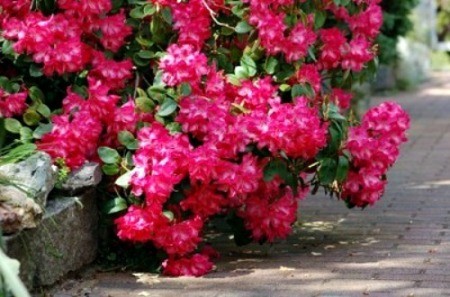
Azaleas are beautiful and versatile in the landscape. They come in a variety of shapes, colors and sizes, and have a wide enough hardiness range that even gardeners in the coldest of zones can enjoy growing them. These ornamental shrubs are very particular about the conditions they grow in-especially the soil. They are not necessarily more difficult to grow than other landscape shrubs, as long as you give them what they need.
Botanically speaking, all azalea plants are in fact Rhododendrons. Azaleas are a subset of the Rhododendron genus. To add to the taxonomic confusion, the rhododendron plant (small 'r') is also a member of the Rhododendron (capital 'R') genus. Although similar in appearance, azaleas typically have smaller leaves and flowers and bloom a bit earlier in the spring than rhododendron plants do. Both are available as deciduous and evergreen types, although the evergreen species are generally the more popular of the two. Many types of azalea and rhododendron cultivars exist (evergreen hybrids, deciduous hybrids, and deciduous standards), Not all cultivars are suitable to every location. Before planting either type of shrub, contact area nurseries (or your local county extension agent) for a list of which cultivars are best suited to growing in your area.
Good drainage, acidic soil, and plenty of organic matter are absolute essentials, so most gardeners can expect to do at least some soil preparation to make azaleas feel at home. These plants like everything in moderation-including the sun. Although they will grow and bloom in full sun, azaleas are native to woodlands. They will hold their blossoms and flower color longer if grown in partial shade in an areas sheltered from winter winds. Steer clear of planting them close to large deciduous trees like maples, that will easily out compete these less aggressive shrubs for nearby nutrients.
Soil preparation: Start with a soil test. Azaleas prefer acidic soil with a pH range of somewhere between 4.5 to 6.0. They will suffer and fail to thrive in alkaline soil. The results of your soil test will tell you what you need to add (e.g. sulfur) to adjust the pH. Once amended, you can keep the soil acidic by adding a cup of sulfur to the soil around each plant in the early spring.
Moisture: Adequate moisture is critical for azaleas, especially while becoming established. Although they prefer moist soil, they also need adequate drainage to prevent soggy roots. If you have clay soil, you'll need to amend it with equal parts of coarse sand and organic matter or consider growing these shrubs in raised beds to improve drainage. Gardeners with sandy soils should double up on the organic matter (hummus) to help the soil retain moisture long enough to be taken up by the roots.
Mulching: Azaleas have shallow root systems, so be very careful when working around the base of them. They will benefit greatly from a few inches of acidic mulch (pine bark, pine needles, or oak leaves) applied around the base, which will protect their roots and help conserve moisture.
Fertilizer: As with exposure to light, pruning, and other aspects of cultivation, azaleas prefer being fed in moderation. Both dry and water-soluble organic fertilizers specially formulated for azaleas are readily available at most garden centers. Once the plants establish their roots, most recommend scattering a handful of slow release organic fertilizer near each plant once in the early spring and again in the fall (dry), or dissolving a small amount in water (wet) and feeding plants every three weeks. Always read and follow directions on the label carefully.
As for the practice of putting fertilizer directly in the bottom of the hole when planting-don't do it! Their roots are shallow and easily burned and the results can often be fatal.
Azaleas seldom need pruning, although it's sometimes necessary to control their size and shape. The ideal time for pruning is right after the plants have finished blooming in the spring. Any pruning after June can jeopardize next year's flowers.

About The Author: Ellen Brown is an environmental writer and photographer and the owner of Sustainable Media, an environmental media company that specializes in helping businesses and organizations promote eco-friendly products and services.
Add your voice! Click below to comment. ThriftyFun is powered by your wisdom!
I have two azaleas that puzzle me. They are planted side by side, but only one blossoms regularly. The white one is full of blossoms but the fuschia colored one blooms once every few years. Even in a good year it might have a few buds but most of the time it doesn't blossom.
Add your voice! Click below to comment. ThriftyFun is powered by your wisdom!